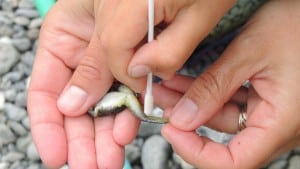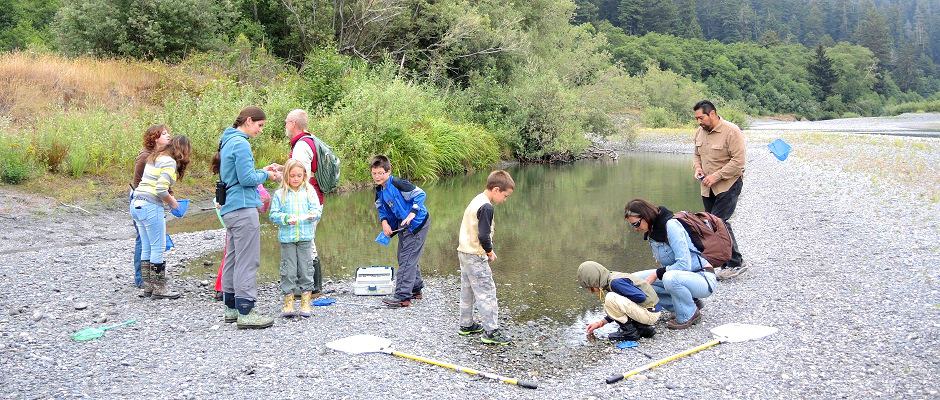Share this article
Kids document diseased amphibians in California
Young citizen scientists aged 4 to 16 have discovered that many frogs and toads on California’s northern coast are infected with the deadly chytrid fungus (Batrachochytrium dendrobatidis). Seventeen percent of amphibians sampled were positive for the disease, which is harmless to humans but is decimating amphibian populations worldwide.
Past studies have assessed chytrid infections in surrounding areas such as Washington, Ore., and more inland parts of California. But Humboldt County has received comparatively little attention, despite being home to diverse amphibian populations, says Richard Botzler, professor emeritus at Humboldt University and senior author of the study published last month in the Journal of Wildlife Diseases. Two previous studies have documented the disease in red-legged frogs (Rana aurora) in the area, but until now, no one had surveyed the county’s other amphibian species.
“We knew that the chytrid was up there,” said Botzler. “But other than that, there was essentially no information about this fungus, which is causing worldwide declines and extinctions of amphibians.”

An adult volunteer holds a frog while a young Ecoclub member swabs its skin to test for chytrid fungus. ©Ecoclub families and staff
To find out more about chytrid in Humboldt County, Botzler joined forces with local kids. The idea stemmed from Botzler’s experience in the Peace Corps in Mexico, where he and his wife Sally Botzler became involved with an environmental youth club network called Ecoclubs International. When the couple returned home from the Peace Corps, they founded a new Ecoclub at the bilingual school their grandchildren attended, offering kids from diverse backgrounds a chance to protect and investigate the natural world.
Botzler taught club members and their adult family members how to handle amphibians gently and swab their skin for testing. Then, he took the team frog hunting once a month for close to two years, alternating between sites at Redwood National and State Parks and Humboldt Bay National Wildlife Refuge. Researchers at the University of California, Davis and the Integral Ecology Research Center tested the samples for chytrid DNA, while a researcher from the U.S. Forest Service helped with data analysis.
Of the 155 amphibians sampled, 17 percent tested positive for chytrid. All the positive samples came from the four most common species: northern red-legged frog, foothill yellow-legged frog (Rana boylii), Pacific chorus frog (Pseudacris regilla) and western toad (Anaxyrus [Bufo] boreas). The fungus, which grows best in cool weather, was more widespread during the colder winter and spring seasons.
Surprisingly, samples collected by children were almost twice as likely to test positive for chytrid, compared with those collected by teens and adults. This pattern didn’t quite reach stricter cutoffs for statistical significance, so it could be a coincidence. Alternatively, it could be that adults and teens in the study used poorer techniques because they were less carefully supervised, says Botzler. In either case, he says it is highly unlikely that there was anything wrong with the children’s samples. Past research has found that while chytrid tests sometimes fail to detect infected amphibians, they essentially never return positive results for animals that are actually disease-free.
“For the youth, at least, I supervised every swab. And I had no trouble saying ‘you might want to twirl that swab a little more, press a little bit harder, a little bit lighter,’ or whatever the case may be,” said Botzler. “My sense is that the techniques that the youth used were very good, including even the 4- and 5-year-olds.”
The project’s 12-year-old leader, Dakota AndersonSpirit, traveled with Botzler to present the first year’s findings in a poster session at the 2014 Wildlife Disease Association Conference in New Mexico. Later, all the Ecoclub members had a chance to review the study before it was published, giving them experience with every stage of the scientific process. Their work demonstrates that researchers of all ages can make valuable contributions to science.
“I no longer think to myself, ah, that’s a new species, you’d better let me do that one,” said Botzler. “Those youth can do it just as well.”
Header Image: Members of the Bilingual McKinleyville Ecoclub search for amphibians in Redwood National and State Parks in 2013. Data collected by the club revealed that a deadly fungal disease is widespread in the area’s frogs and toads. ©Ecoclub families and staff








